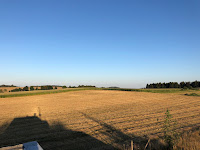Update at solar site in Eagle Mountains: LoRa APRS digi, WX, MeshCom, Meshtastic, LoRa PR
After a long time I finally found the time and made a day trip to the Eagle Mountains to inspect and upgrade the solar site. The trip got a bit complicated when I discovered that I didn't have the keys to QTH OL7M :) Fortunately it was sorted out - thanks Káťo. We loaded up the ladder and headed for the mountains. The morning rain turned into hot and sweltering heat at 1100m.
I planned to change the batteries and most importantly add new technologies - Meshtastic and MeshCom. I also replaced the SD card in the raspberry PI zero for the LoRa Packet Radio to make both LoRa TRXs operational. Replaced the LoRa APRS WX station etc.
In the end it was a 4h job...
I installed new dipole for 433 and 868 MHz on one boom. 868 MHz is used for LoRa APRS WX station and 433 MHz for MeshCom. There is also new 3el collinear antenna for 868 MHz with 433 MHz filter for Meshtastic.
The power system works by having a main 12V 17Ah battery, this is charged by two solar panels 10 and 20W. My own MPPT charging boards also have battery discharge protection and their own DC-DC converter for 3V3 and 5V. Either board powers 3V3 stuff, like the LoRa APRS Digi and the 5V Raspberry PI zero board. The 3V3 board shuts off the battery when it drops to 11.5V and the 5V board at 12V. The weather station has its own 18650 battery that powers the LoRa APRS WX and the RAK 19003 for the Meshtastic. This metostation monitors and sends the main 12V battery voltage and Meshtastic sends the small battery voltage information. This WX station has its own small solar panel.
In case the small battery in the WX station becomes disconnected, the main battery will be powered via 3V3 voltage.
There are now:
LoRa APRS digi - OK2ZAW-17
Frequency: 433775 kHz, slow 300bps
ANT: 4el collinear
LoRa APRS WX - OK4ZAW-16
Frequency: 869525 kHz, slow 300bps
ANT: dipole (with 433MHz)
LoRa Packet Radio - OK2ZAW-1 and -7
BBS + NODE
Frequency TNC 1: 869525 kHz
preamble = 8
spreadingFactor = 7
bandwidth = 250000
codingrate = 5
Frequency TNC 2: 433075 kHz
preamble = 8
spreadingFactor = 7
bandwidth = 62500
codingrate = 5
ANT: H-pol Yagi to 210deg.
MeshCom
Frequency: 433175 kHz
ANT: dipole (with 868MHz)
Meshtastic
Frequency: 869525 kHz
ANT: 3el collinear
Antennas and power boards + raspberry PI zero and LoRa TRX
LoRa APRS WX board with own MPPT power system
LoRa Packet Radio - OK2ZAW-1 and -7This is an experimental Packet Radio BBS and Node with two LoRa modems. You can find more (including SD card image)
here
I tested the possibility of a 100km connection and with a small Yagi antenna there was no problem to communicate without failures. The signal was at 0 - 1dB SNR.
Test at 100km distance from JN79WK
MeshCom
This Austrian project is quite interesting and again uses LoRa modules and the 433.075 MHz frequency. It uses routing technology and so it is not only possible to send messages to users anywhere in the world possibly within a Radio Mesh network.
In the Eagle Mountains I installed a dipole towards approximately 310deg. Even so, I am able to communicate at 100km again only with the dipole at approximately -15dB SNR. When I experimented with the Yagi antenna I achieved up to 5dB SNR.
Are you interested in any of the projects? Feel free to get started :)
I also plan to offer KIT antennas - dipoles, collinear arrays including splitter and outdoor boxes...


















































